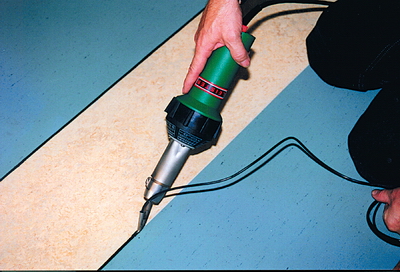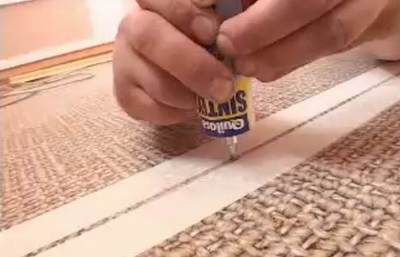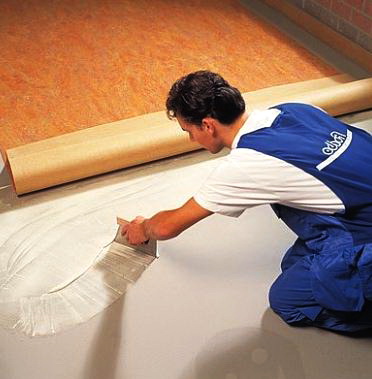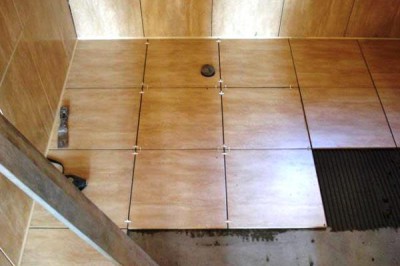Cold and hot welding of linoleum in stages and instructions
For high-quality and inconspicuous junction of two linoleum panels, two methods of their connection, called hot or cold welding, are used. The type of coating to be applied affects the choice of welding method. Cold welding of linoleum can be used to glue the edges of any PVC coating. However, most often it is used when working with household linoleum, the thickness of which is minimal, as well as strength characteristics. However, for flooring in apartments, this material is the most optimal. In public institutions with high throughput, commercial linoleum is laid, capable of withstanding maximum loads. Therefore, the joints of such a coating require a stronger connection, which provides a hot welding method. At the same time, rather expensive equipment is used, which is available only to professionals engaged in the provision of services in the field of repair work in general, and in laying linoleum, in particular.
Hot welding: melting technology
This method is ideal for gently joining linoleum, which contains natural ingredients. When working, special equipment and a cord for welding linoleum are required, which is made of fusible material, melting under the influence of high temperature.
The hardened polymer reliably seals the joint, making it virtually invisible. To create the required melting temperature, a linoleum welding machine is needed, which has compact dimensions and is connected to a conventional power supply network.
Hot welding steps:
- Before starting work on gluing the seam, it is necessary to process the edges of linoleum with a special knife. In this case, a kind of groove is formed, the depth of which reaches the base of the coating.
- The seam area is thoroughly cleaned of dust and debris.
- The hair dryer for welding linoleum is turned on and the temperature is set, which should be 350-400 ° C. Then a special nozzle is installed, into which a piece of a welding cord is inserted with a length slightly exceeding half of the weld being welded.
- Having located the end of the cord in the previously prepared groove, the hair dryer begins to move along the seam. At the same time pay attention to the melting quality of the cord.
- After the welding stage is completed, they begin to remove the excess softened cord, using a sickle-shaped knife and a special nozzle for cutting the cord. Work with a knife gently, placing it parallel to the surface of the coating to avoid damage to linoleum.
- One seam is welded in two steps, starting work from opposite sides, and welding is performed at the place where the cords overlap.
Important! Operation, despite its apparent lightness, requires professional skills. Therefore, it is better to trust the hot welding of linoleum to masters in whose experienced hands the tool for welding linoleum works like a clock.
Nuances and subtleties of cold welding
To carry out cold welding of household linoleum joints, glue is used, which is sold in special tubes. For accurate application of the adhesive to the joint area of the webs, a needle-shaped tip is inserted into the tube, which ensures the penetration of the chemical substance to the entire depth of the joint.
Important! To protect the surface of linoleum from glue, the seam is glued with tape.Further, in the joint area, the adhesive tape is cut and adhesive for linoleum is applied to the formed space - cold welding. Excess glue is removed with a damp cloth. The glue completely dries in 10 minutes. After half an hour, the coating can be operated normally.
The cold welding method does not require special equipment and special skills, so it can be applied at home by anyone.
However, it is necessary to choose the right glue, which manufacturers produce for various purposes, using markings in the form of Latin letters:
- Type A glue is purchased for laying new linoleum.
- A glue of type C, which has a thicker consistency, is used for cold welding of long-laid linoleum.
- Type T glue is recommended for durable bonding of linoleum joints made of their polyester-based PVC materials.
Important! Cold welding of linoleum joints should be carried out with protective gloves, taking into account the precautions indicated by the manufacturer on the tube. The work is carried out in a room with an open window leaf, which allows the volatile solvents contained in the adhesive to weather.
If desired, the seams can be made contrasting, which will increase the decorative qualities of the laid coating. For this, cords of various colors are acquired, and some instances may even glow in the dark. The more parts of linoleum stick together, the more expensive the cost of welding. Also, the cost of the service is affected by the qualification of the master and his level of employment in the market. Save on quality is not worth it, since linoleum fits for decades. These technologies find their application in the restoration of linoleum, damaged during intensive use.






1 comment